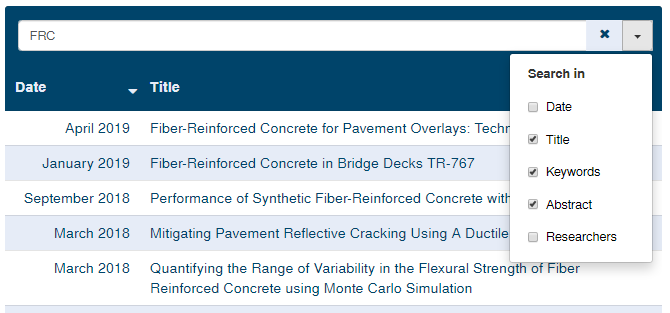History of the CP Road Map
 The CP Road Map (or Long-Term Plan for Concrete Pavement Research and Technology) was an innovative program developed and jointly implemented by the concrete pavement stakeholder community.
The CP Road Map (or Long-Term Plan for Concrete Pavement Research and Technology) was an innovative program developed and jointly implemented by the concrete pavement stakeholder community.
The CP Road Map aimed to prioritize and coordinate the nation’s concrete pavement research so that effective tools and practices could be implemented to reliably deliver sustainable concrete pavements and its story is outlined below as follows.
Background | History | Accomplishments | Research Tracks | So what now?
Background
For most of the 20th century, the same materials—portland cement, aggregate, and water—were used in pavement concrete with only minor refinements. It was a fairly forgiving system that allowed some flexibility in material quality, construction practices, and other variables without sacrificing pavement performance.
For generations, the industry had enjoyed the luxury of keeping traffic off new concrete pavements for several days (even weeks) while the concrete developed its design strength. By the end of the 20th century, however, the following changes had turned the process of concrete paving on end:
- The availability of the highest quality materials had diminished and environmental pressures—including air quality, water quality, and land use permit concerns—were increasingly affecting mix designs and pavement construction practices.
- Traffic volumes had increased rapidly and the demand for better roadway conditions in winter had led to extensive use of deicing material across the nation.
- Truck weights had increased significantly, requiring increased structural capacity from pavements with less leeway for design insufficiencies and construction defects.
- Increased performance requirements—for example, motorists wanting smoother, quieter pavements—had reduced tolerance for variation.
- Complex mix designs had led to compatibility problems, forcing a closer look at which properties were critical.
- Highway budgets were being squeezed at every level, with the pavement community continually being asked to do more with less.
- Highway agency focus had shifted from building new pavements to rehabilitating and maintaining existing ones, requiring different designs, systems, materials, and equipment.
- Motorists had become more demanding, accepting only minimal road closures and delays due to roadwork, which increased the need for new paving methods that would allow road crews to get in, get out, and stay out.
It was no longer possible for the concrete pavement community to continue doing business as usual, while meeting the growing highway construction and rehabilitation demands. The CP Road Map gave the concrete pavement community the opportunity to proactively reinvent itself through research and technology transfer.
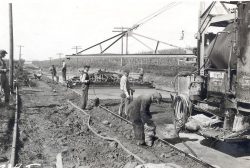
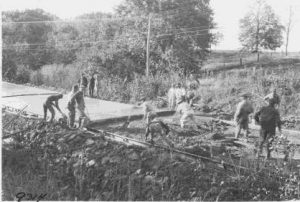
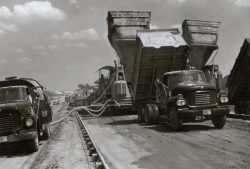
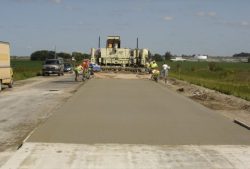
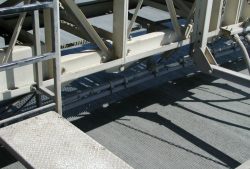
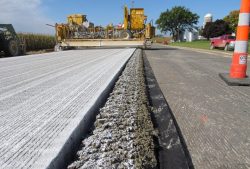
Above black-and-white photos courtesy of the Iowa DOT
and color photos courtesy of Todd Hanson
and the Iowa DOT, used by permission
History
The vision for the CP Road Map began in 2001 and was outlined in an agreement between the Innovative Pavement Research Foundation (IPRF) and the Federal Highway Administration (FHWA). Iowa State University’s Center for Portland Cement Concrete Pavement Technology (now the National Concrete Pavement Technology Center at Iowa State University’s Institute for Transportation) was chosen to lead the development and manage the implementation activities of the CP Road Map. This partnership culminated in 2005 in the publication of an initial Executive summary, Volume I: Background and summary, and Volume II: Research tracks.
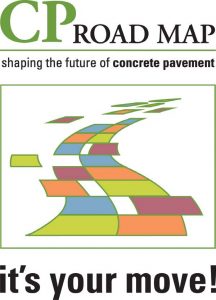 Between 2006 and 2013, the original CP Road Map took shape through administrative support from an FHWA contract (DTFH61-06-D-00023) and the pooled fund TPF-5(185) that included six states (lead state IA, with MI, MS, NY, PA, and VA).
Between 2006 and 2013, the original CP Road Map took shape through administrative support from an FHWA contract (DTFH61-06-D-00023) and the pooled fund TPF-5(185) that included six states (lead state IA, with MI, MS, NY, PA, and VA).
The CP Road Map was grounded from the beginning in acknowledgment that no single organization had the funds, expertise, or political capital to focus all research being done across the concrete pavement community. Thus, the CP Road Map brought to the same table representatives from national, state, and local agencies, academia, and industry for collaborative brainstorming sessions to assemble and synthesize research priorities. Ultimately, more than 400 stakeholders engaged in identifying critical needs and distilling them into twelve major research tracks (listed below).
The CP Road Map sought also to connect funding agencies with researchers by having a national set of research priorities that state highway administrations (SHAs) and other research funding entities could use to prioritize local funding and collaboration opportunities. Joint funding partnerships between FHWA, SHAs, and academia were established on many CP Road Map priorities that multiplied the cost effectiveness of research spending by allowing partners each to invest less, yet accomplish more.
In 2013, through FHWA-sponsored pooled fund TPF-5(286), the Next Generation CP Road Map was established, engaging five states (lead state IA, with GA, MI, OK, and PA) as well as industry partners in continued cooperative involvement in research and technology transfer. This support undergirded an updated CP Road Map Volume I: Background and summary and Volume II: Research tracks.
Ultimately, over the course of 10 years, the CP Road Map investment enabled concrete-pavement-related sponsored research programs to leverage resources and help researchers funnel effort toward the stakeholder community’s top priorities. One of the very innovative early products of the CP Road Map was the Integrated Materials and Construction Practices for Concrete Pavement: A State-of-the-Practice Manual (now in its 2nd edition), which for the first time communicated in a user-friendly manner the growing complexity of mixture design, materials selection, and construction practices. Additional CP Road Map accomplishments are below.
Accomplishments
Key CP Road Map accomplishments include the following:
- Ranking of concrete pavement research needs enabling state DOTs to optimize resource use via working together with other states sharing the same research concerns
- Quarterly “CP Road Map E-News” newsletter (now the “NC² E-News”) highlighting new developments in concrete pavement research and technology around the country
- Quarterly Moving-Advancements-into-Practice (MAP) tech briefs introducing technologies ready to strengthen practitioners’ concrete paving practice
- A curated and searchable online Concrete Infrastructure Research Database of in-progress and recent research, enabling states to determine the state-of-the-art for any concrete pavement technology as well as its pros and cons in relation to particular paving contexts
Research Tracks
12 primary research tracks and several subtracks were identified by the CP Road Map Executive Committee. The committee then prioritized the 12 tracks (priority tracks marked * below), obtained executive-level buy-in to the CP Road Map, and cultivated collaborative sponsorship of research across the nation.
The 12 key research tracks of the CP Road Map, with their respective goals, are detailed below.
1: Materials and Mixes*
The goals of the CP Road Map’s “Materials and Mixes” track were to develop and deliver integrated tools and techniques for specifying, proportioning, and constructing mixtures that meet the combined needs of owners and contractors: constructible, long-lasting, sustainable, cost-efficient, and verifiable concrete pavements. The topic is important because today’s materials for concrete mixtures have changed rapidly as environmental, cost, and performance constraints have become more stringent.
2: Performance-Based Design Guide for New and Rehabilitated Pavements*
The goals of the CP Road Map’s “Performance-Based Design Guide for New and Rehabilitated Pavements” track were to continue enhancing the next generation of mechanistic approaches to pavement design and improving their integration with materials, construction, and environmental inputs. A major element of the track was helping agencies and contractors successfully make the change from strictly empirical design approaches to mechanistic approaches.
3: Intelligent Construction Systems and Quality Assurance*
High-speed nondestructive testing and intelligent construction systems can continuously monitor pavement properties during construction to provide rapid feedback. As a result, automatic adjustments can ensure a high-quality finished product that meets performance specifications. The goal of the CP Road Map’s “Intelligent Construction Systems and Quality Assurance” track was to develop nondestructive testing methods that use continuous and real-time sampling to monitor performance-related mix properties, reducing the number of human inspectors and improving construction operations.
4: Optimized Surface Characteristics for Safe, Quiet, and Smooth Pavements*
For the CP Road Map’s “Optimized Surface Characteristics for Safe, Quiet, and Smooth Pavements” track, the concrete pavement industry worked together to develop specifications and guidelines to design, construct, and maintain concrete pavements that are safe, comfortable, durable, and cost-effective. The goal was concrete pavements that invoke a pleasant human experience and address an array of societal needs.
5: Equipment Automation and Advancements
The goal of the CP Road Map’s “Equipment Automation and Advancements” track was to enable concrete paving process improvements and equipment advancements that would expedite and automate PCC pavement rehabilitation and construction, resulting in high-quality concrete pavements, reduced waste, and safer working environments.
6: Innovative Joint Design, Materials, and Construction
The goal of the CP Road Map’s “Innovative Joint Design, Materials, and Construction” track was to identify, develop, and test new and innovative joint concepts for concrete pavements that are more cost-effective, reliable, and durable than current alternatives.
7: Maintenance and Preservation*
The CP Road Map’s “Maintenance and Preservation” track aimed to identify both conventional and innovative pavement types, design features, foundations, materials, construction QC/QA, and preservation treatments able to provide long service life (e.g., more than 40 years) and reliability.
8: Construction, Reconstruction, and Overlays*
The CP Road Map’s “Construction, Reconstruction, and Overlays” track explored new and existing products and technologies to facilitate high-speed rehabilitation and construction of portland cement concrete pavements, focusing particularly on concrete overlays.
9: Evaluation, Monitoring, and Strategies for Long-Life Pavements
The “Evaluation, Monitoring, and Strategies for Long-Life Pavements” track aimed to collect, manage, and analyze concrete pavement performance data supporting the CP Road Map.
10: Foundations and Drainage
The CP Road Map’s “Foundations and Drainage” track aimed to provide pavement engineers with tools to better design, construct, and evaluate both foundations and drainage systems for concrete pavements.
11: Business Systems and Economics*
This CP Road Map track addressed business and economic issues in concrete paving. It had two main goals: (1) to address the management and financing of the Executive Committee functions, including innovative management systems, and (2) to address concrete pavement economics.
12: Sustainability*
The concrete pavement “Sustainability” track was the last addition to the CP Road Map. The objective of this track was to identify and complete research and implementation that improves concrete pavement sustainability through the pavement’s life cycle (design, materials selection, construction, operation, maintenance, restoration, rehabilitation, and recycling).
So what now?
The CP Tech Center continues to carry on the important legacy of the CP Road Map as follows:
- Keeping a finger on the pulse of agencies’ research and technology transfer needs to help them prioritize national and regional pooled fund and TRB funding
- Maintaining the Concrete Infrastructure Research Database to streamline users’ review of ongoing research nationwide
- Continuing to publish a regular newsletter of national research and technology transfer resources and new MAP Briefs summarizing research findings via funding from FHWA through the Technology Transfer Concrete Consortium (TTCC) transportation pooled fund TPF-5(437)

